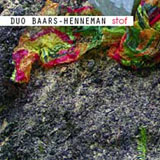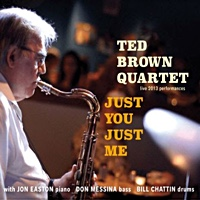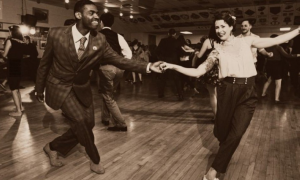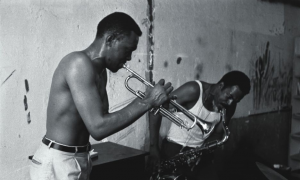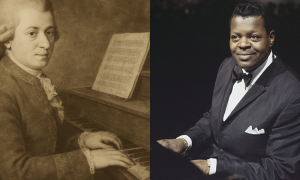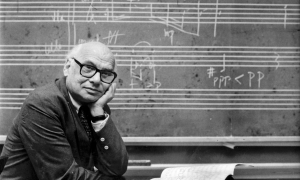Home » Jazz Articles » Opinion » Tango? Not according to the Latin Academy
Tango? Not according to the Latin Academy
I am left wondering about this committee of experts in tango and jazz, who carefully tallied up the percentage of tango in my CD and decided I came up short.
This past summer, members of the Latin Academy of Recording Arts and Science (LARAS) were mailed voting instructions for the prestigious Latin Grammy Awards 2007.
Voting on a wide variety of genres and subgenres, such as Brazilian, Mexican, tango, Latin jazz, members will have to choose among 100s of recordings submitted for nomination by the LARAS membership, a distinguished group of industry insiders, musicians, record labels, producers, etc. to which I am honored to belong.
 In the tango category, voters will take their pick from a list of 19 releases. Unfortunately, the list does not include my most recent recording Buenos Aires Tango Standards (Zoho Music). This CD, a collection of traditional tangos performed by a group of Argentine musicians, was deemed outside the category by the Latin Recording Academy.
In the tango category, voters will take their pick from a list of 19 releases. Unfortunately, the list does not include my most recent recording Buenos Aires Tango Standards (Zoho Music). This CD, a collection of traditional tangos performed by a group of Argentine musicians, was deemed outside the category by the Latin Recording Academy.According to an email from LARAS: "During the screening meeting, the Pablo Aslan recording was carefully screened by experts in both jazz and tango. The committee listened to the recording and felt the recording did not have enough tango elements to remain in the Tango category and therefore it remained in the Jazz category." Furthermore, "Our rule is: Genre-specific albums must consist of 75% or more playing time of the specific genre."
I am left wondering about this committee of experts in tango and jazz, who carefully tallied up the percentage of tango in my CD and decided I came up short. I am flattered that the jazz experts consider my music part of that great tradition, which has been so important in my musical upbringing. I am not sure there is 75% jazz in my music, though, but that may not be important to them. I find that by nature jazz musicians are very open-minded.
We Argentines are very jealous of our tango and put premium value on authenticity. I should know, after all, I've devoted the last 20 years of my life to playing, studying and teaching this music.
My trajectory as a tango musician is long and as they say, part of the public record. In the late '80s and early '90s, long before tango became the ubiquitous phenomenon it now is, I was a regular fixture in tango clubs across the United States. I played for 100s of dancers in Los Angeles, Seattle, Oakland, Denver, New York, Boston, Washington, Portland, etc. I also traveled to South America, Europe, Japan and Russia playing with some of the best tango musicians in the world (Nestor Marconi, Fernando Suarez Paz, Pablo Ziegler, Alberto Podesta, Horacio Deval, Raul Jaurena, to name a few) and with other non-tango musicians who approached the music with reverence. One such non-tango musician who contracted my services was Yo Yo Ma, with whom I toured the US and Japan alongside Astor Piazzolla's old sidemen. When Shakira asked her producer, the legendary Argentine arranger Jorge Calandrelli, to hire top-notch tango artists to record the introduction to her hit "Obsession", I was flown to Miami to lend my expertise and authenticity.
This situation reminds me, of course, of the trouble Astor Piazzolla had with his brand of tango. The animosity that his music engendered speaks of the passion that Argentines share for the tango. Yet nowadays nobody but the most recalcitrant dinosaurs would dare call Piazzolla's music anything other than tango. But according to the Latin Academy's rules, he would be not be admitted into the tango category: imagine, he used an electric guitar, hardly a traditional tango instrument at the time he introduced it. That's 20% of his quintet's orchestration! Piazzolla's rhythmic concept, while rooted in tango, was entirely his own. Well, let's say it was only about 45% tango, being generous and the rest is in his particular non-danceable beat (ask around in the tango dance halls what they think of Piazzolla as tango dance music). His compositions? Well, he mostly wrote his own, unlike traditional artists, who rearrange from the standard repertoire, as I did on my CD. Piazzolla's main influences were Béla Bartók, JS Bach, Igor Stravinsky and Gerry Mulligan and so on. Mr. Piazzolla, it's clear, would not be in the tango category, according to the LARAS experts.
On Buenos Aires Tango Standards I assembled a group of Argentine musicians who are equally versed and experienced in tango and jazz. For the repertoire, I chose from among the most traditional instrumental tangos written by Arolas, Bardi, Laurenz, Maffia, Salgan, all part of the tango canon. Drummer Daniel Piazzolla (there is that name again!) and I developed our rhythmic concept from a set of traditional tango rhythms that I transcribed from classic tango bands (Di Sarli, Pugliese, Calo, Pontier, Gobbi). The rhythms that we play are all traditional marcatos, sincopas and milongas—the essence of tango. You just have to know how to hear past the drums, bass and piano rhythm section format and understand this is not swing, not ska, not AfroCuban... it's tango. Pianist Abel Rogantini, a veteran of the famed Orquesta Escuela de Tango and an active tango freelancer in Buenos Aires, is able to bridge both worlds by infusing the music with rich jazzy harmonies using tango rhythms and concepts. And the horn players... Well, if you can get past the lack of bandoneon and violin and hear what these musicians are doing, you realize why I had to go all the way to Buenos Aires to make this recording. Gustavo Bergalli and Jorge Retamoza play their horns as a tango singer, as a bandoneonist would, as Argentine musicians with full knowledge and love of the tango tradition do, regardless of their instruments' traditional value (or percentage thereof). I would not have it any other way.
Who are the gatekeepers of the tango category at LARAS? Who are these experts who passed judgment on my brand of tango and considered it not "tango" enough? What else do they consider not-tango? Recent Latin Grammy nominations of recordings by Pablo Ziegler and Adrian Iaies, artists whom I consider to be very close to my aesthetic and clearly not traditional tango, make it even more confusing to understand where they draw the line.
But we could hardly expect the Latin Academy to subject all submitted nominations to such an intense scrutiny. Take Brazilian music: most artists there make liberal use of jazz instrumentation and harmony and they don't think twice about using reggae or guajira or rock rhythms as part of their palette. I doubt you would exclude Caetano Veloso or Carlinhos Brown from the Brazilian music category. And think of an analogous situation in the jazz category! Well, actually, that has happened before and the results were invariably scandalous.
If the tango experts can't hear what it is that I'm doing with this music, perhaps they should listen closer. Given my trajectory, they may even have to acknowledge that they don't know enough about tango rhythms and forms to pass judgment on this music. And they must understand the tango tradition as a living, breathing thing. Tango is alive, it's not stuck in the past and you should expect it to sound different today than it did in the so-called Golden Era of the '40s. I feel that my work over the past two decades has contributed to the validity of tango as a contemporary, dynamic genre. It's too bad Latin Academy voters will not have a chance to acknowledge this.
Tags
PREVIOUS / NEXT
Support All About Jazz
 All About Jazz has been a pillar of jazz since 1995, championing it as an art form and, more importantly, supporting the musicians who make it. Our enduring commitment has made "AAJ" one of the most culturally important websites of its kind, read by hundreds of thousands of fans, musicians and industry figures every month.
All About Jazz has been a pillar of jazz since 1995, championing it as an art form and, more importantly, supporting the musicians who make it. Our enduring commitment has made "AAJ" one of the most culturally important websites of its kind, read by hundreds of thousands of fans, musicians and industry figures every month.




